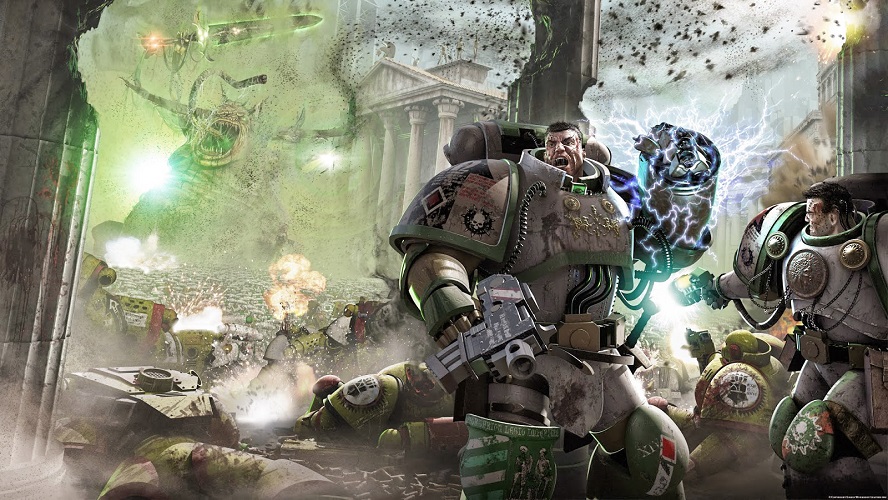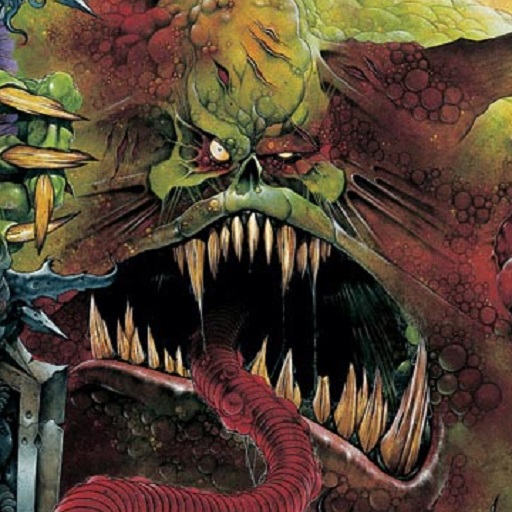Warning: This post contains dripping, rotten, festering spoilers. Stop reading now if you’re somehow unaware of the corruption of the Death Guard or the events of the Horus Heresy and want to read this book from a naïve perspective.

I recently finished reading The Flight of the Eisenstein, by James Swallow. In general, it was a fun book to read. I’d recommend the book to anyone interested in learning more about the history of the Death Guard, or the Horus Heresy. That means that it should be interesting to anyone who likes Warhammer 40,000 lore, because the Heresy is the fundamental origin story underpinning the whole fictional universe. I didn’t realise until after I finished reading it that The Flight of the Eisenstein isn’t actually the first book in the Horus Heresy series; there are 3 books preceding it. I can only assume that they’re more in the vein of preludes rather than actual beginnings, because it is in Eisenstein that the Heresy really begins. So if you’re looking for a good place to get a solid entry point into the history without committing to 20+ books of detail, Eisenstein is the perfect book for you. As a big fan of ‘classic’ science fiction, I guess I came into this with somewhat low literary expectations. Indeed, if you’re expecting poetic elegance, subtle character development, and intricate plot twists, you’re going to be disappointed. But if you’re a fan of the Death Guard (which you should be if you’re reading my blog!) and just want an entertaining read, then Eisenstein will fit the bill.
The prose is functional. It’s obviously not trying to be overly stylistic, and nor should it. It does come off as a bit formulaic and uninspired in places though. There isn’t the faintest shred of subtlety. But it doesn’t seem fair to judge this book as a piece of high literature. It’s game fluff-fiction, and it fulfils that role excellently. The descriptions and action are detailed and accurate, which is important for an audience that already has extremely strong visual expectations of how everything in the universe should look.
There were a few things that annoyed me about the story. The Lodges aboard the Death Guard space vessels were made out to be a big deal, but without any compelling evidence of why. The Lodges are clandestine groupings of soldiers, gathering and discussing things in secret. That’s it. Every organisation has closed-door meetings and gossip, so if you want me to believe that this is somehow sinister and precipitous, then you need to convince me of that. As it is, the Lodges are just a weak plot device to draw attention to the seeds of sedition. Luckily the Lodges only appear early on in the book, and become irrelevant as soon as the Heresy begins in earnest, which was also when I started really enjoying the book.

I liked observing the gradual descent into Heresy. Of course everyone reading the book already knows what will happen in broad terms, and the author knows that we know. But it’s entertaining to watch the growing discomfort and awareness of the protagonist, Nathaniel Garro. When the drop-site massacre began, I was dreading long and tedious tugging of emotional heartstrings, because who has time that stuff? But I was pleasantly surprised when it was quickly dispensed with. Restraint is a good sign in writing, avoiding the low-hanging fruit and moving on with the story smartly. I even found myself a little awed by the scale of the betrayal, despite my initial pessimism.
Here’s a line that stuck with me:
“The time would come, Typhon promised himself, and it would be soon,
when he would cut loose from Mortarion’s shadow and stand alone.”
 I like the irony in the statement. 10,000 years later, Typhon (now Typhus) still hasn’t found his yearned for independence. This spurred my imagination, and gave me some ideas for how to cast Typhus in army’s lore and even how to model him. I’m going to make him a bitter, withered wretch. Not the triumphant captain represented by the updated model’s pose, but the spiteful, hunched, diminished (by modern Death Guard model standards) creature still toiling in Mortarion’s shadow ten full millennia later. He’ll still be a powerful figure, no doubt, but more a Napoleonic one, shorter than his underlings, and twisted by long resentment.
I like the irony in the statement. 10,000 years later, Typhon (now Typhus) still hasn’t found his yearned for independence. This spurred my imagination, and gave me some ideas for how to cast Typhus in army’s lore and even how to model him. I’m going to make him a bitter, withered wretch. Not the triumphant captain represented by the updated model’s pose, but the spiteful, hunched, diminished (by modern Death Guard model standards) creature still toiling in Mortarion’s shadow ten full millennia later. He’ll still be a powerful figure, no doubt, but more a Napoleonic one, shorter than his underlings, and twisted by long resentment.
I felt that the narrative was solid for most of the book. Unfortunately I was disappointed by the final act. The story had been trending toward an ever grander scope from the first  engagement against the xenos to the Heresy and flight to imperial space. The story was getting BIG. Then at the end it slipped way down, and finished with a bland bout of fisticuffs… The final melee wasn’t even particularly exciting. Garro’s final opponent, the Lord of the Flies, was insignificant compared with all the other baddies encountered previously. The only thing cool about it was the vividly horrific description of the Lord of the Flies. His transformation scene was great, even if the subsequent fight was lacking in comparison. The biggest let-down though was the illustration near the end of that chapter, which totally failed to do justice to the description. The nothing especially wrong with the picture, as such. It just looks far too plain for an end-boss, not nearly hideous or chaotic enough for a follower of Nurgle. In fact, I think it looked more like a Genestealer than a daemon of decay. I’m just glad that GW sculptors since then have gone with more imaginative mutations for the Death Guard.
engagement against the xenos to the Heresy and flight to imperial space. The story was getting BIG. Then at the end it slipped way down, and finished with a bland bout of fisticuffs… The final melee wasn’t even particularly exciting. Garro’s final opponent, the Lord of the Flies, was insignificant compared with all the other baddies encountered previously. The only thing cool about it was the vividly horrific description of the Lord of the Flies. His transformation scene was great, even if the subsequent fight was lacking in comparison. The biggest let-down though was the illustration near the end of that chapter, which totally failed to do justice to the description. The nothing especially wrong with the picture, as such. It just looks far too plain for an end-boss, not nearly hideous or chaotic enough for a follower of Nurgle. In fact, I think it looked more like a Genestealer than a daemon of decay. I’m just glad that GW sculptors since then have gone with more imaginative mutations for the Death Guard.
 What stuck with me afterwards was the philosophical depiction of Nurgle. Not cruel, even if many of his nascent champions were. At first briefly mocking the despair of Solun Decius, but only briefly, then changing to caring and nurturing mercy. I was also left with a curiosity to read more, to learn more about Nurgle and the antagonists or the story, particularly Typhus. Despite being a fundamentally unlikeable character, he did make me curious to learn about his descent into the dark powers. Mortarion on the other hand, despite being a far more powerful figure in the lore, failed to evoke much interest for me. He was altogether too dull.
What stuck with me afterwards was the philosophical depiction of Nurgle. Not cruel, even if many of his nascent champions were. At first briefly mocking the despair of Solun Decius, but only briefly, then changing to caring and nurturing mercy. I was also left with a curiosity to read more, to learn more about Nurgle and the antagonists or the story, particularly Typhus. Despite being a fundamentally unlikeable character, he did make me curious to learn about his descent into the dark powers. Mortarion on the other hand, despite being a far more powerful figure in the lore, failed to evoke much interest for me. He was altogether too dull.
Unfortunately from my brief investigations into the Black Library it doesn’t seem like much has been written about the Death Guard, especially post-Heresy. There are just a few short stories building on the main characters a little. Hopefully that will change soon though, now that the Death Guard have become the prime antagonists in the Dark Millennium storyline. Fingers crossed for the Lords of Silence!
Score: 3.5 oozing, writhing, fly-ridden tentacles out of 5.

Cover art by Neil Roberts. Miniature pictures are the property of Forge World. The Flight of the Eisenstein, Death Guard, Horus Heresy, Warhammer 40K, etc are all property of Games Workshop. The Lord of the Flies illustrator unknown.

If you want to learn the importance of the lodges read the first 3 books about the Luna wolves, they explain the importance and why they lead to the heresy!
LikeLiked by 1 person